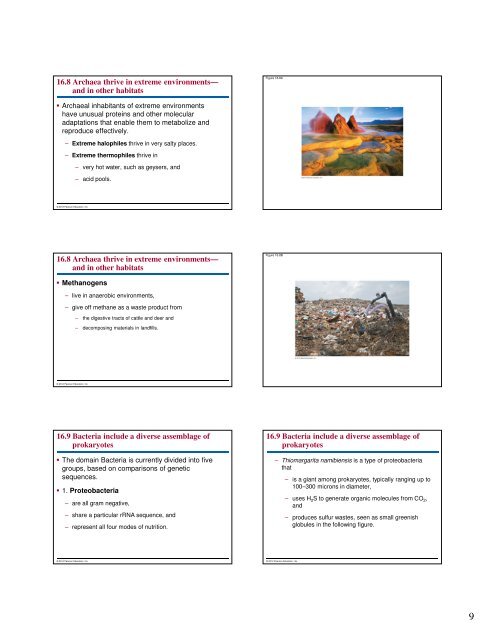Microbial Life: Prokaryotes and Protists - Renz Science
Microbial Life: Prokaryotes and Protists - Renz Science
Microbial Life: Prokaryotes and Protists - Renz Science
Create successful ePaper yourself
Turn your PDF publications into a flip-book with our unique Google optimized e-Paper software.
16.8 Archaea thrive in extreme environments—<strong>and</strong> in other habitatsFigure 16.8A Archaeal inhabitants of extreme environmentshave unusual proteins <strong>and</strong> other molecularadaptations that enable them to metabolize <strong>and</strong>reproduce effectively.– Extreme halophiles thrive in very salty places.– Extreme thermophiles thrive in– very hot water, such as geysers, <strong>and</strong>– acid pools.© 2012 Pearson Education, Inc.16.8 Archaea thrive in extreme environments—<strong>and</strong> in other habitatsFigure 16.8B Methanogens– live in anaerobic environments,– give off methane as a waste product from– the digestive tracts of cattle <strong>and</strong> deer <strong>and</strong>– decomposing materials in l<strong>and</strong>fills.© 2012 Pearson Education, Inc.16.9 Bacteria include a diverse assemblage ofprokaryotes The domain Bacteria is currently divided into fivegroups, based on comparisons of geneticsequences. 1. Proteobacteria– are all gram negative,– share a particular rRNA sequence, <strong>and</strong>– represent all four modes of nutrition.16.9 Bacteria include a diverse assemblage ofprokaryotes– Thiomargarita namibiensis is a type of proteobacteriathat– is a giant among prokaryotes, typically ranging up to100–300 microns in diameter,– uses H 2 S to generate organic molecules from CO 2 ,<strong>and</strong>– produces sulfur wastes, seen as small greenishglobules in the following figure.© 2012 Pearson Education, Inc.© 2012 Pearson Education, Inc.9


